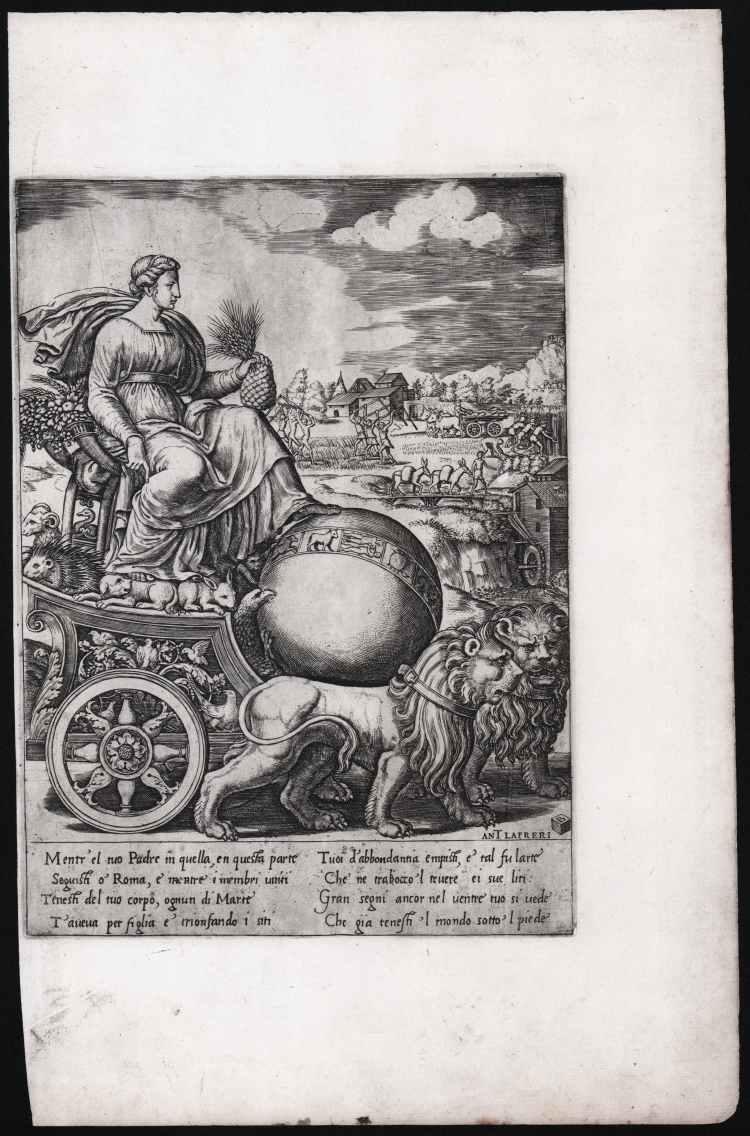





| Reference: | S48428 |
| Author | Maestro B nel Dado |
| Year: | 1530 ca. |
| Measures: | 180 x 250 mm |




| Reference: | S48428 |
| Author | Maestro B nel Dado |
| Year: | 1530 ca. |
| Measures: | 180 x 250 mm |
The scene shows the goddess Cybele on the chariot, dragged by lions, with one foot resting on the globe, the symbol of the world.
Engraving, ca. 1530, from a drawing by Baldassarre Peruzzi (1481- 1536) preserved in the British Museum.
Example in the second state of six (second of three for Massari), with Antonio Lafreri's imprint at right.
Magnificent proof, richly toned, printed on contemporary laid paper without watermark, with full margins on three sides, trimmed at left copperplate, in excellent condition.
In Renaissance Italy, artists, patrons and other educated people were fascinated by the tales of classical mythology, which were revived in new Latin editions and Italian translations. Often the gods and heroes of ancient texts were adapted for symbolic purposes to convey moral or political ideas. Cybele was an ancient Anatolian deity worshipped as the Mother Goddess of Nature. She was an ambivalent deity who symbolized both the creative force and the destructive force of nature. The origin of her cult was Phrygia from which she expanded after the seventh century B.C. to the Greek colonies of Anatolia, Greece, and later to Rome. Cybele was generally depicted seated on a chariot drawn by two lions representing the mythological characters of Hippomenes and Atalanta, transformed by Zeus into beasts and condemned to drag Cybele's chariot as punishment for desecrating a temple of the goddess.
“La stampa, che il Bartsch ritiene invenzione di Giulio Romano, riproduce in controparte il disegno raffigurante Cibele o Roma sul carro trascinato da leoni, già attribuito a Perin del Vaga, considerato, a partire dal Popham, di Baldassarre Peruzzi conservato al British Museum (inv. 1880-5-8-82, mm. 251x204; fig. 21; cfr. Pouncey-Gere, 1962, n. 243). I versi che si leggono sulla incisione confermano tale identificazione, il soggetto è infatti un'allegoria della città di Roma vista nel suo aspetto di dea della fertilità e dell'abbondanza mentre incede sul carro guidato da leoni secondo la poetica descrizione che ne fanno nei loro poemi Ovidio (Fasti, IV,) e Lucrezio (De rerum natura, II). La composizione richiama quella di un antico bassorilievo (L'Altare di Scipione) ora a Villa Albani (Reinach, Reliefs, III, p. 134) sicuramente noto al Peruzzi dal momento che lo ha disegnato nel taccuino di Siena (fol. 57). È pertanto probabile che il disegno di Londra costituisca un modello per l'incisore che nella stessa epoca incide un altro disegno del Peruzzi, l'Ercole che scaccia la discordia dal tempio delle Muse su ordine di Apollo (Bartsch, XV. 17). Baltasar Perutius Senen inuentor è infatti la scritta che appare nell'edizione di Philippe Thomassin di questo rame del Maestro del Dado conservato in Calcografia. Entrambe queste incisioni sono stilisticamente affini per Pouncey-Gere con la serie di quattro stampe realizzate dallo stesso incisore per illustrare la favola di Apollo e Dafne (Bartsch, XV, pp. 196-197) la cui invenzione viene ora assegnata al Peruzzi, smentendo l'attribuzione tradizionale a Giulio Romano. Rispetto al disegno del British Museum il Maestro del Dado ha aggiunto il paesaggio sullo sfondo con i contadini al lavoro e numerosi particolari, diverso e più ornato è il carro su cui appaiono, al posto dei due leoni del disegno, un cinghiale, una lepre, un ariete, un cane e un'aquila, la divinità non è turrita come nel disegno e indossa un abito molto più ricco. È probabile che queste aggiunte siano da attribuire allo stesso incisore fantasioso e interessantissimo interprete di temi mitologici” (cfr. S. Massari, Tra Mito e Allegoria, p. 98).
Bibliografia
Bartsch, Le Peintre graveur (XV.195.18); S. Massari, Tra Mito e Allegoria, pp. 98-99, n. 30 II/III.
Maestro B nel Dado (Attivo a Roma, metà XVI sec.)
|
Master del Dado was trained as painter and engraver in Marcantonio’s workshop; he was born around 1512 and worked in Rome between 1532 and 1550. He is very often mistaken with Beatricetto or Bonasone.
Le Blanc believes that he was a descendant of Bernardo Daddi (1512 – Rome 1570), a painter, according to the monogram that signs his prints. Some others identify him with Benedetto Verini, presumed son of Marcantonio, which would have explained the monogram BV on his plates. According to Bartsch though, the V might stand for Venetian or again for Tommaso Vincidor da Bologna.
He engraved drawings of other artists for Lafrery; his favourite subjects were Raphael, Peruzzi, Giulio Romano and Tommaso Vincidor.
To Master del Dado have been ascribed about 85 prints, according to Malaspina and also Bartsch says they are 85, while Passavant believes they are 89.
|
Maestro B nel Dado (Attivo a Roma, metà XVI sec.)
|
Master del Dado was trained as painter and engraver in Marcantonio’s workshop; he was born around 1512 and worked in Rome between 1532 and 1550. He is very often mistaken with Beatricetto or Bonasone.
Le Blanc believes that he was a descendant of Bernardo Daddi (1512 – Rome 1570), a painter, according to the monogram that signs his prints. Some others identify him with Benedetto Verini, presumed son of Marcantonio, which would have explained the monogram BV on his plates. According to Bartsch though, the V might stand for Venetian or again for Tommaso Vincidor da Bologna.
He engraved drawings of other artists for Lafrery; his favourite subjects were Raphael, Peruzzi, Giulio Romano and Tommaso Vincidor.
To Master del Dado have been ascribed about 85 prints, according to Malaspina and also Bartsch says they are 85, while Passavant believes they are 89.
|